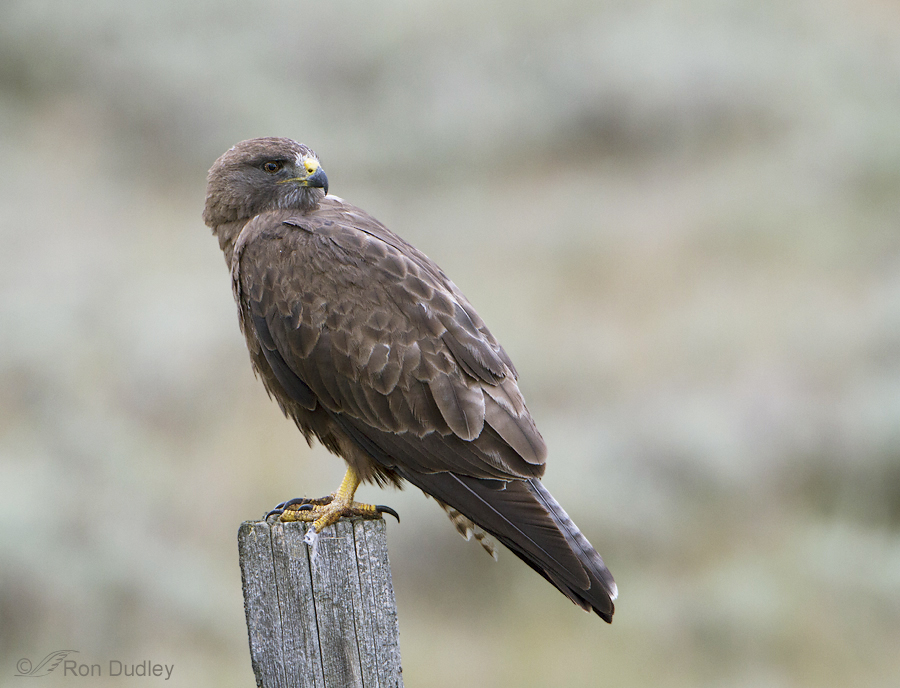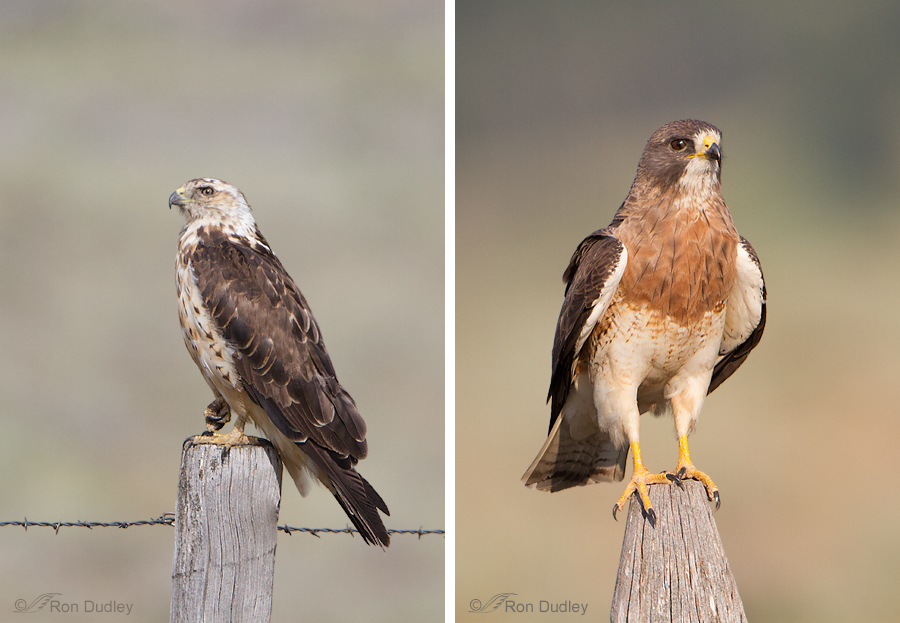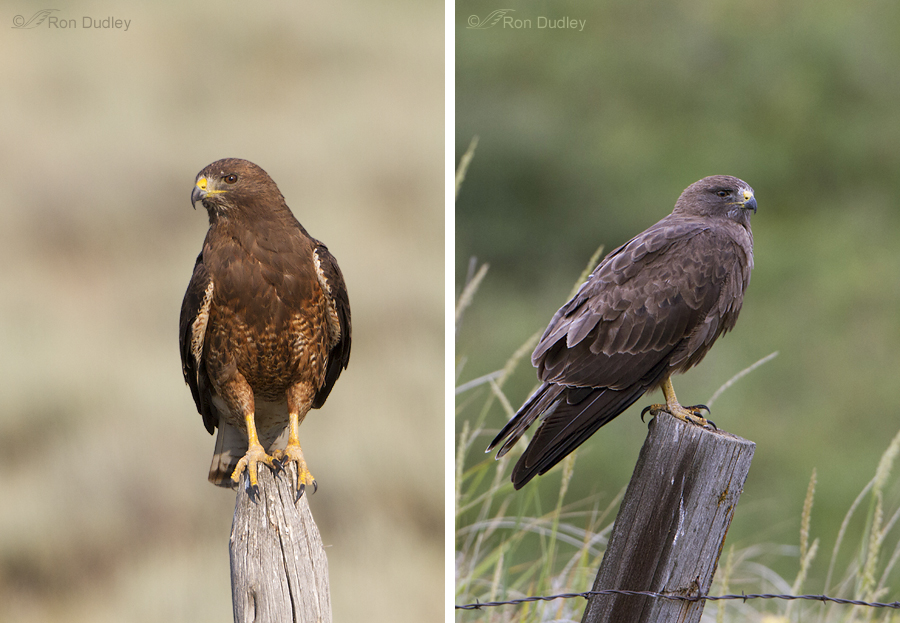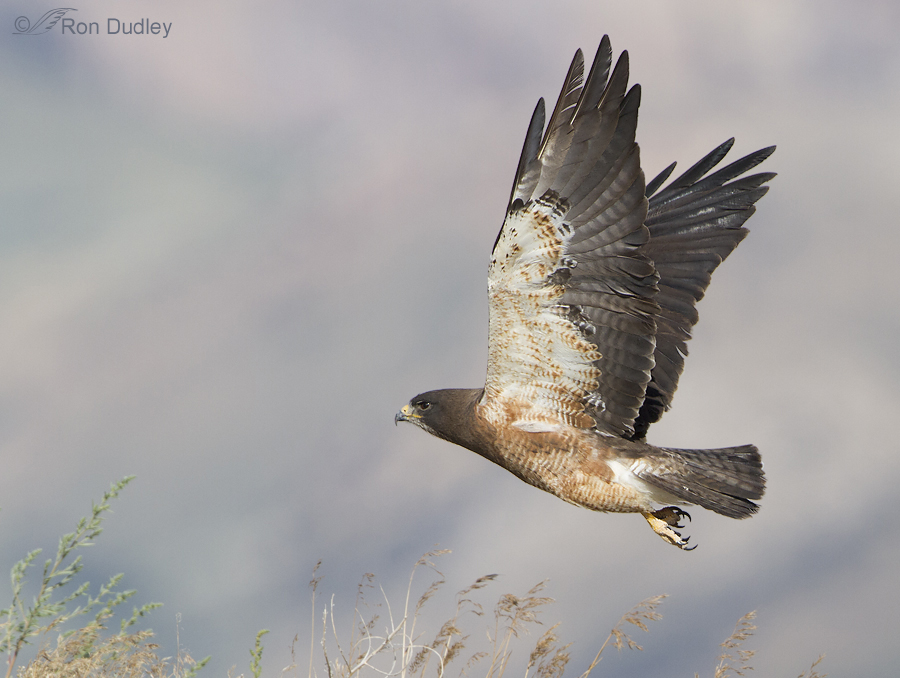This is the last in my four part series on the color morphs of the Swainson’s Hawk. Today the focus is on the dark morph.
The body of the adult dark morph is uniformly brown or rufous brown. I have very few images of the uncommon dark morph and those I do have were taken in poor light and are side views so it’s somewhat difficult to see that they lack the more rufous belly of the intermediate morph.
This dark morph is turned slightly more toward the viewer than in the previous image so it’s a little easier to see that dark brown belly.
Both of these images were taken in July of last summer in the Centennial Valley.
I thought it might be a little easier for the viewer to distinguish between the morphs and remember some of the differences if I had photos of each of them together so that’s what I’ve done, below. But remember that color variation in Swainson’s Hawk morphs is almost continuous from darker to lighter individuals so there would be a lot of in-between birds.
LIGHT MORPH JUVENILE TRANSITIONING INTO A SUBADULT LIGHT MORPH
INTERMEDIATE MORPH DARK MORPH
Swainson’s Hawks are the most gregarious of all North American raptors and in summer may form very large flocks that forage together and use communal nocturnal roosts. This flock was flying over the Centennial Mountains on our last Montana trip. This is less than half of the hawks that were in the group. I count about 30 birds in this image but we estimated at the time that there were roughly 70 of them, total – many were out of frame.
1/2000/ f/7.1, ISO 500, 500 f/4, 1.4 tc, not baited, set up or called in
Earlier in this series I lamented the fact that although I’ve been successful in photographing Swainson’s Hawks in Montana this summer I’ve struck out with them here in Utah – until two days ago when I photographed this intermediate morph taking off out in the west desert. The bird was slightly past me but perhaps this is a sign that I’ll have more luck with them before they leave us for the winter.
Ok, enough of Swainson’s Hawks for a while. I’ve probably overdone them recently…
Ron








Great great morph variation pics Ron. In south-central NM I have come across their nests in tall yucca that are maybe 5 feet above the ground. More than once I have been on my 16 hand horse and stumbled across a nest I am looking down upon. Needless to say that startled both the nesting female, my horse and myself and I quickly reined Buck away to give the nest as wide a berth as possible. On Wyoming’s Continental Divide Swainson’s are the raptor most frequently seen taking advantage of man-made nesting platforms that have been built as oil/gas development mitigation. What a sight it must be to see them flying together…. I am forwarding your morph pics to a few biologist co-worker/friends. Not only gorgeous to view but educational as well! Mucho grazzzzzz
Wow! What a wonderful series Ron!
Charlotte Norton
Hi Ron, I’m new to raptors and fell passionately in love with the red-tailed hawks of the Cornell lab cams.. Seeing your photos has peaked my interest again and hope to learn more about these Swainson’s hawks.. They are beautiful, Loved the series Thank you
I’m glad you enjoyed the series, Sandy. Thank you.
Never enough SWHAs. Never too many SWHA photos!
I know you’re a fan of this species, Mike. Me too. And the more I learn about them the more I’m drawn to them.
And thanks for including all the morphs on the final post. I was hoping you would and you did!
I’m glad you appreciated that, Abby. It seemed like the natural thing to do for this series.
Seeing seventy hawks at once would have had me dislocating my jaw in amazement. What an incredible sight.
Thank you for this series – and I really appreciated you putting up the differing morphs side by side for comparison.
My jaw was certainly hanging in amazement, Elephant’s Child. I won’t soon forget the sight.
Hi Ron, thank you for sharing these beautiful images. Your picture of the kettle reminds me of my very first encounter with Swainson’s Hawks – a small kettle of 30-40 birds in Montana in 1983. A nice memory. Thanks again!
Thank you, Dick. I avoided using the word “kettle” in this post because I’ve seen some definitions of the word that apply only to large groups of these birds when they’re migrating or preparing to. These birds weren’t ready to migrate yet so I didn’t use the term. I guess I’m not sure of the proper usage…
No no….never to much hawk talk..lol.
Great comparison pictures Ron.
I noticed they are all photographed on fence posts….any story on that or just by chance?
Tim
Tim, The bottom of the Centennial Valley itself has very few trees for perching. All that’s available is fence posts, power poles and a few rocks. I don’t like the power poles as perches for a variety of reasons but I don’t mind the old, weathered posts – thus, the post perches in these shots.
Seeing that many raptors together must be a fantastic sight. The light morph bird remains my favourite, but it’s been a most enjoyable series, so thanks for sharing it.
It was, Sonja – it surely was. First time for me with this many of them.